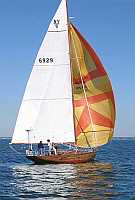Difference between revisions of "Spinnaker"
| Line 3: | Line 3: | ||
Spinnakers come in two varieties: symmetric and asymmetric. | Spinnakers come in two varieties: symmetric and asymmetric. | ||
| + | === Symmetric Spinnaker === | ||
| + | [[IMAGE:S_sail.jpg|thumb=S_sail_thumb.jpg|right|A sloop with a symmetric spinnaker]] | ||
A '''Symmetric spinnaker''' resembles a tall isosceles triangles. Either lower corner can be either a tack or a clew. It must be deployed with a '''spinnaker pole'''. The spinnaker pole is attached to the mast at one end, it uses a [[topping lift]] to support its weight, and it often uses a [[foreguy]] to help control its vertical position -- it should be kept parallel to the water. The spinnaker pole is deployed to the windward side of the boat (opposite from the mainsail). A sheet runs to the leward corner of the sail, and an [[afterguy]] runs to the pole to control its horizontal position. | A '''Symmetric spinnaker''' resembles a tall isosceles triangles. Either lower corner can be either a tack or a clew. It must be deployed with a '''spinnaker pole'''. The spinnaker pole is attached to the mast at one end, it uses a [[topping lift]] to support its weight, and it often uses a [[foreguy]] to help control its vertical position -- it should be kept parallel to the water. The spinnaker pole is deployed to the windward side of the boat (opposite from the mainsail). A sheet runs to the leward corner of the sail, and an [[afterguy]] runs to the pole to control its horizontal position. | ||
| + | === Asymmetric Spinnaker === | ||
'''Asymmetric spinnakers''' (or '''A-sails''') are more like very large [[Genoa|genoas]]. One corner is the tack, which is attached at the bow of the boat. Sometimes a '''tack line''' is tied to the corner of the sail and runs through a block at the bow of the boat to allow the sail to rise up above the level of the deck. The other corner is the clew which is attached to a sheet. Asymmetric spinnakers do not use a pole. | '''Asymmetric spinnakers''' (or '''A-sails''') are more like very large [[Genoa|genoas]]. One corner is the tack, which is attached at the bow of the boat. Sometimes a '''tack line''' is tied to the corner of the sail and runs through a block at the bow of the boat to allow the sail to rise up above the level of the deck. The other corner is the clew which is attached to a sheet. Asymmetric spinnakers do not use a pole. | ||
Revision as of 09:40, 1 May 2009
A Spinnaker is a large, bulbous foresail that is used for downwind sailing. Spinnakers are usually made of very light material and resemble a parachute when deployed; sometimes a spinnaker is referred to as a "chute". Spinnakers often have colorful designs on them.
Spinnakers come in two varieties: symmetric and asymmetric.
Symmetric Spinnaker
A Symmetric spinnaker resembles a tall isosceles triangles. Either lower corner can be either a tack or a clew. It must be deployed with a spinnaker pole. The spinnaker pole is attached to the mast at one end, it uses a topping lift to support its weight, and it often uses a foreguy to help control its vertical position -- it should be kept parallel to the water. The spinnaker pole is deployed to the windward side of the boat (opposite from the mainsail). A sheet runs to the leward corner of the sail, and an afterguy runs to the pole to control its horizontal position.
Asymmetric Spinnaker
Asymmetric spinnakers (or A-sails) are more like very large genoas. One corner is the tack, which is attached at the bow of the boat. Sometimes a tack line is tied to the corner of the sail and runs through a block at the bow of the boat to allow the sail to rise up above the level of the deck. The other corner is the clew which is attached to a sheet. Asymmetric spinnakers do not use a pole.
